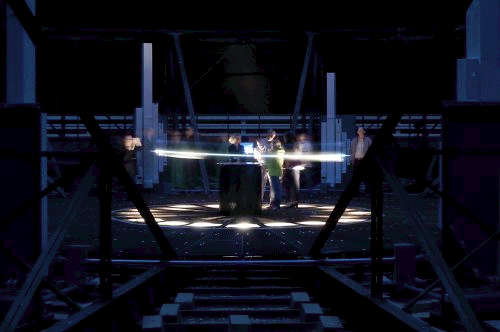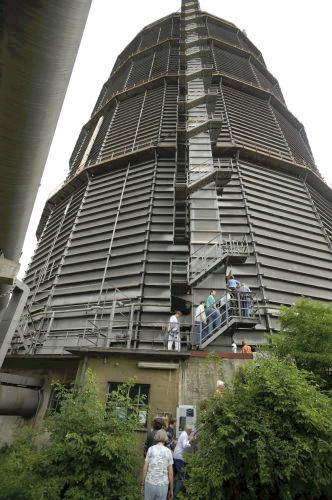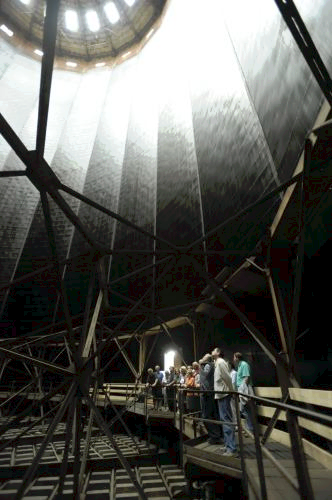
photo: W. Nienstedt
The Foucault pendulum inside the Augsburg gasometer is among the world's largest installation of this kind (it is several meters longer then the famous one at the Panthéon in Paris). As a consequence, the pace of its movement is very slow. It takes 17 seconds to complete one swing.
A hypnotizing experience - unfortunately, the significance of the elegant physics experiment goes mostly unnoticed: As the earth and we rotate around the swinging pendulum, the pendulum seems to change its orientation over time. However, as it take about 32 hours for a full rotation of the pendulum's plane, the change is just a tiny 0.05 degrees per swing. It takes quite a while until deviations show up that are visible to the naked eye. Listening to the soundscape, the perception changes: Knowing that the earth will turn five hundredths of a degree with each note, your ear becomes a very precise measuring device.
As the music is slowed down about 100 times compared to the original, its structure completely disappears. Nonetheless, you will sense that the notes sounding are definitely not arbitrary. The harmonic plan laid out by the brilliant composer prevails. There is no need for musical background knowledge or familiarity with the piece to experience the harmonic progression.
It's rather unlikely any visitor will experience a complete recital of the prelude taking almost three hours. But hopefully you will become curious about what happens next, how the tensed chord you may be experiencing will resolve to a more pleasant one. About every 13 minutes the harmonic quality inside the gasometer changes. As the various sound sources interact, each location inside the soundscape brings about a different sensation.
A hypnotizing experience - unfortunately, the significance of the elegant physics experiment goes mostly unnoticed: As the earth and we rotate around the swinging pendulum, the pendulum seems to change its orientation over time. However, as it take about 32 hours for a full rotation of the pendulum's plane, the change is just a tiny 0.05 degrees per swing. It takes quite a while until deviations show up that are visible to the naked eye. Listening to the soundscape, the perception changes: Knowing that the earth will turn five hundredths of a degree with each note, your ear becomes a very precise measuring device.
As the music is slowed down about 100 times compared to the original, its structure completely disappears. Nonetheless, you will sense that the notes sounding are definitely not arbitrary. The harmonic plan laid out by the brilliant composer prevails. There is no need for musical background knowledge or familiarity with the piece to experience the harmonic progression.
It's rather unlikely any visitor will experience a complete recital of the prelude taking almost three hours. But hopefully you will become curious about what happens next, how the tensed chord you may be experiencing will resolve to a more pleasant one. About every 13 minutes the harmonic quality inside the gasometer changes. As the various sound sources interact, each location inside the soundscape brings about a different sensation.

If you listen carefully while approaching the building, you can make out the song of the gasometer over the din of the industrial area surrounding it. At the base of the stairwell leading up to the viewing gallery on top of the structure the giant tin can has turned into a sound sculpture.
Climb the stairs to a height of 87 meters and experience how the sound and the barely noticeable vibration of the steel changes. The view across the city from the areas second highest viewing point is also worth the effort.
Climb the stairs to a height of 87 meters and experience how the sound and the barely noticeable vibration of the steel changes. The view across the city from the areas second highest viewing point is also worth the effort.

Feel like staying 10,000 seconds for a complete run of the prelude? There is lots of space to find a comfortable position.